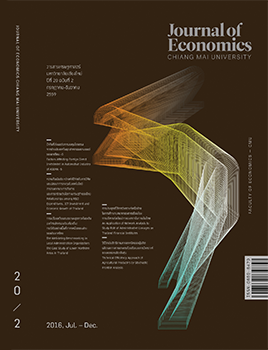วิธีวัดประสิทธิภาพทางเทคนิคของผู้ผลิตผลิตผลทางการเกษตร ด้วยตัวแบบวิเคราะห์ขอบเขตผลผลิตเชิงสุ่ม
Keywords:
ประสิทธิภาพการผลิต, ระดับประสิทธิภาพทางเทคนิค, ผู้ผลิต, ขอบเขตผลผลิต, การวิเคราะห์ขอบเขตผลผลิตเชิงสุ่ม, Production efficiency, Technical efficiency score, Producer, Frontier production, Stochastic frontier analysis (SFA)Abstract
บทคัดย่อ
บทความนี้มีจุดประสงค์เพื่อนำเสนอความสำคัญและวิธีศึกษาการวัดประสิทธิภาพทางเทคนิคการผลิตผลิตผลทางการเกษตรแบบมุ่งเน้นการใช้ปัจจัยการผลิตด้วยตัวแบบการวิเคราะห์ขอบเขตผลผลิตเชิงสุ่ม (SFA) ประสิทธิภาพทางเทคนิคมีความสำคัยสำคัญที่จะทำให้เกิดการผนึกกำลังกันของนักวิจัยและ/หรือนักขับเคลื่อนนโยบายทั่วโลก โดยเฉพาะประเทศกำลังพัฒนาและประเทศพัฒนาแล้ว นิยมใช้ระดับประสิทธิภาพทางเทคนิคเป็นตัวชี้วัดประสิทธิภาพการผลิตทางการเกษตรโดยเฉพาะการผลิตข้าวหรือผลิตผลอื่นๆ เนื่องจากมีผลต่อการเติบโตทางด้านผลิตภาพการผลิตข้าวของประเทศ ประสิทธิภาพการผลิตถูกนำเสนอตามแนวคิดของ Farell (1957) ทั้งนี้ ในส่วนของประสิทธิภาพทางเทคนิคแบบมุ่งเน้นการใช้ปัจจัยการผลิต Farell อธิบายว่าเป็นความสามารถของผู้ผลิตในการใช้ปัจจัยการผลิตหรือเทคโนโลยีการผลิตที่มีอยู่ให้น้อยที่สุดเพื่อผลิตผลผลิตให้ได้สูงสุดที่เป็นไปได้ หรือกล่าวอีกนัยหนึ่ง คือ สามารถใช้ปัจจัยการผลิตน้อยแต่ได้ผลผลิตมาก จากแนวคิดของ Farell นำไปสู่การทำนายค่าระดับประสิทธิภาพทางเทคนิค 2 แบบ คือ (1) แบบพาราเมทริก ซึ่งเป็นเทคนิคทางเศรษฐมิติที่ใช้การประมาณค่าขอบเขตผลผลิตเชิงสุ่มด้วยตัวแบบ SFA ร่วมกับตัวแบบอิทธิพลความไม่มีประสิทธิภาพ (IEM) (2) แบบนอนพาราเมทริก ซึ่งเป็นเทคนิคการวัดด้วยโปรแกรมเชิงเส้นตรงด้วยตัวแบบ DEA สำหรับเครื่องมือวัดระดับประสิทธิภาพทางเทคนิคของผู้ผลิตผลิตผลทางการเกษตรในระดับสากล ตัวแบบ SFA จะได้รับความนิยมมากที่สุด เนื่องจากสามารถวัดประสิทธิภาพทางเทคนิคและความไม่มีประสิทธิภาพทางเทคนิคที่เกิดจากความคลาดเคลื่อนที่ผู้ผลิตไม่สามารถควบคุมได้ในช่วงการผลิต ไม่ว่าจะเป็นความคลาดเคลื่อนจากตัวผู้ผลิตหรือความคลาดเคลื่อนจากภายนอกที่ผู้ผลิตไม่สามารถควบคุมได้ ซึ่งความคลาดเคลื่อนเหล่านี้ล้วนมีอิทธิพลต่อขอบเขตผลผลิตทั้งสิ้น
Abstract
The purpose of this article is to present the cucial role and studying approach of agricultural produce input-saving oriented technical efficiency measurement by stochastic frontier analysis ; SFA . They have been widely collaborated by both researchers and policy makers around the globe. Measurement of technical efficiency ( ) score in agricultural produce namely rice and others have received particular attention in developing and developed countries because of the importance of productivity growth in country rice production . The concept of production efficiency as proposed by Farrell (1957) describes a measure of input-saving oriented technical efficiency. In addition, Farrell defined as the producer’s ability to produce maximum output given a set of input bundles and technology. Farrell’s definition illustrated above led to the development of methods for estimating the score of producer.
Two quantitative approaches are developed to conceptualize Farrell’s definition of efficiency measurement of unobservable frontier that is parametric based on the econometric estimation of the production frontier (one step simultaneously stochastic frontier analysis incorporated with inefficiency effect model ; IEM) and non-parametric based on the linear programming techniques (Data envelopment analysis (DEA) model). Most of the cited studies employed SFA by the fact that the technique is capable of capturing technical inefficiency
( ) in the production process, measurement error as well as other statistical noise effecting the shape and position of the producer,s frontier production.
Downloads
Published
Issue
Section
License
All opinions and contents in the CMJE are the responsibility of the author(s). Chiang Mai University Journal of Economics reserves the copyright for all published materials. Papers may not be reproduced in any form without the written permission from Chiang Mai University Journal of Economics.
ข้อคิดเห็นที่ปรากฏและแสดงในเนื้อหาบทความต่างๆในวารสารเศรษฐศาสตร์มหาวิทยาลัยเชียงใหม่ ถือเป็นความเห็นและความรับผิดชอบโดยตรงของผู้เขียนบทความนั้นๆ มิใช่เป็นความเห็นและความรับผิดชอบใดๆของวารสารเศรษฐศาสตร์ มหาวิทยาลัยเชียงใหม่
บทความ เนื้อหา และข้อมูล ฯลฯ ในวารสารเศรษฐศาสตร์มหาวิทยาลัยเชียงใหม่ ถือเป็นลิขสิทธิ์เฉพาะของคณะเศรษฐศาสตร์มหาวิทยาลัยเชียงใหม่ หากบุคคลหรือหน่วยงานใดต้องการนำทั้งหมดหรือส่วนหนึ่งส่วนใดไปเผยแพร่ต่อหรือเพื่อกระทำการใดๆ จะต้องได้รับอนุญาตเป็นลายลักษณ์อักษร จากวารสารเศรษฐศาสตร์ มหาวิทยาลัยเชียงใหม่





